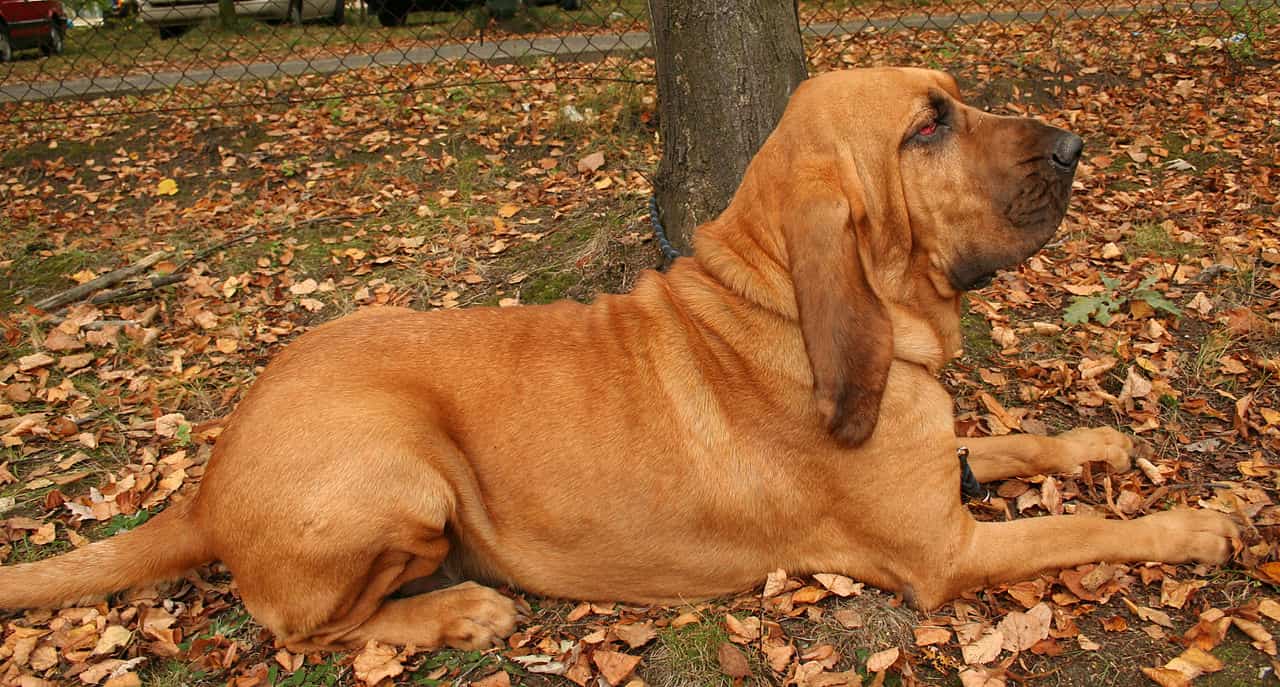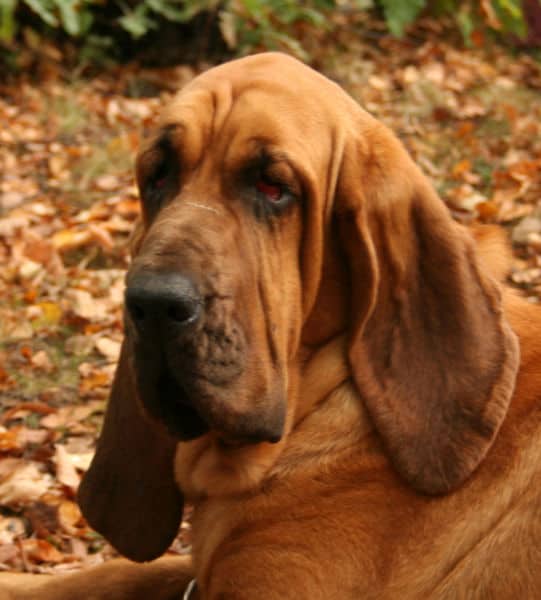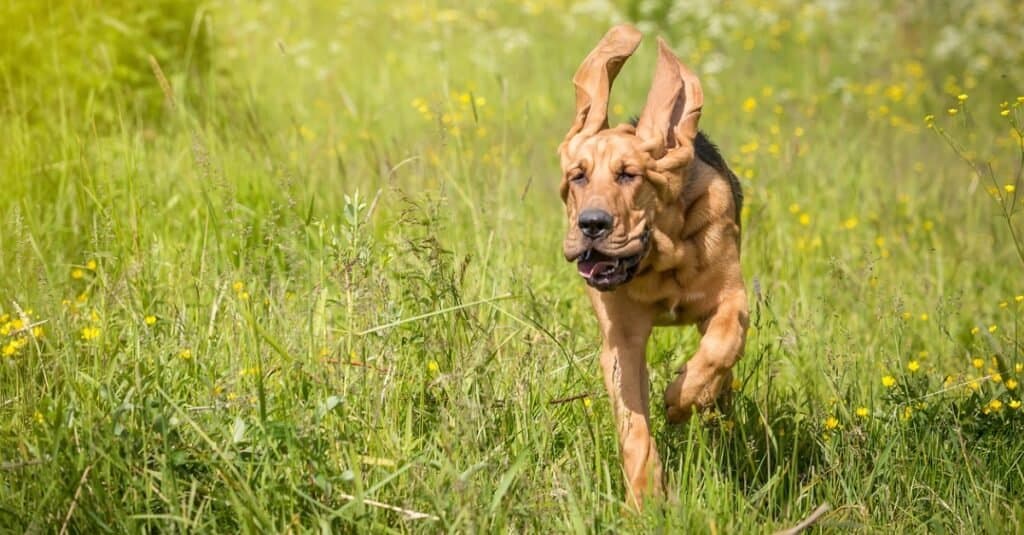
When looking to adopt a new dog, lifespan can be an important factor. You may also already have a Bloodhound and are wondering how long their lifespans are.
Bloodhounds may live anywhere from 6-12 years. An individual Bloodhound’s lifespan depends on their genetics and the care they receive.
In this article, we’ll discuss Bloodhound lifespans, their life cycle, what Bloodhounds commonly die of, and how to lengthen your Bloodhound’s life.

Bloodhounds live 6-12 years on average.
©Pleple2000 / Creative Commons – License
How Long do Bloodhounds Live?
According to the American Kennel Club (AKC), Bloodhounds live an average of 10-12 years. However, a couple of small UK studies showed Bloodhounds living shorter lives of just 6-8 years.
Bloodhound Life Cycle
Puppies
Bloodhounds age a bit more slowly than other puppies, and typically aren’t considered full-grown until around two years old.
This means you might see the puppy stage stick around longer, and adolescence and then maturity will happen later.
Puppy years with a large dog can be challenging, as they have the same phases and misbehaviors as smaller pups. This can include inappropriate chewing and a bit of stubbornness during adolescence.
Keeping your Bloodhound puppy out of trouble at this time will involve mostly management strategies like supervision and keeping things out of their reach. Training will also help, but takes time!
Adults
Bloodhounds are considered adults at two years old. During these years, dogs hit a healthy middle ground. They aren’t as rambunctious and destructive as puppies, but they have a good amount of energy left in them.
They also haven’t slowed down the way seniors tend to, and they typically won’t be facing the health problems that come with old age yet.
Personally, these are my favorite years! You can really get to know who your dog is, develop a daily routine with them, and enjoy your life together.
Seniors
At around six to eight years old, your Bloodhound will be considered a senior. Senior dogs make fantastic companions, especially for people who can’t take the energy that puppies and young adults have.
Seniors tend to mellow out and, as they age, may need to slow down when it comes to exercise or take on less arduous tasks.
Always follow your Bloodhound’s lead–don’t force them into less activity if they’re still acting young and spry, and don’t push them if they naturally begin to slow down.
With less exercise, your dog’s diet may also need to change. This is something to speak about with your veterinarian.
Lastly, you’re likely to see health problems develop as your dog gets older. The age these problems develop will depend on the dog, their genetics, and several other factors.

Leading causes of death in Bloodhounds include Gastric Dilatation Volvulus (GDV, bloat) and cancer.
©Pleple2000, CC BY-SA 3.0, via Wikimedia Commons – License
What do Bloodhounds Typically Die From?
The leading causes of death in Bloodhounds are Gastric Dilatation Volvulus (also known as GDV or bloat) and cancer. I’ve only found small studies looking into the topic, so it’s unclear which is number one and which is the second leading cause.
This study showed GDV as the leading cause at 34%, with cancer at nearly 27%. However, another (even smaller) study showed cancer leading at 43% versus GDV at 22%.
It’s important to remember that these studies had small numbers. The first surveyed 46 participants, while the second had a sample size of only 14.
Gastric Dilatation Volvulus (GDV)
Also known as bloat, this is an emergent health condition where a dog’s stomach fills with gas and flips around inside of their body. Around 30% of dogs who develop bloat will die even with veterinary care.
To give your dog the best chance, it’s vital to know the signs of GDV before adopting a Bloodhound. They include:
- Swollen abdomen
- Stomach pain
- Retching
- Excessive drooling
- Restlessness
If your Bloodhound shows symptoms of GDV, don’t hesitate. Bring them immediately to your nearest emergency vet clinic.
In addition, here are some ways to prevent bloat before it happens:
- Avoid raised food bowls
- Don’t exercise your Bloodhound right before or after meals – most vets recommend waiting about two hours
- Avoid exercise right before or after they drink large amounts of water
- Use slow feeders so that they aren’t scarfing their meals too quickly
- Keep your Bloodhound’s stress levels low, especially around mealtimes
- Feed multiple small meals throughout the day rather than one large meal
- Keep them at a healthy weight (not over or underweight)
Cancer
Cancer is one of the leading causes of death for all dogs. However, Bloodhounds seem to develop cancers earlier in their lives than most other breeds.
There isn’t a way to prevent cancer in your Bloodhound, although breeders should avoid breeding dogs that develop cancer, especially while young. This can decrease the puppies’ risk of suffering the same fate.
Catching cancer early can sometimes give your Bloodhound better odds at beating it. Keep up with routine vet check-ups and always visit the vet if you notice your dog isn’t acting like themselves or seems sick.

Well-bred and cared for Bloodhounds tend to live longest.
©Ermolaev Alexander/Shutterstock.com
How to Increase Your Bloodhound’s Lifespan
Of course, there’s no surefire way to make your Bloodhound live longer. Some things are out of our control.
However, we can still take care of our dogs to the best of our ability. This will often help to increase their lifespans.
Purchase From a Reputable Breeder
Genetics play a large role in how long a Bloodhound will live. Reputable breeders screen for genetic ailments in their lineage and won’t breed dogs with histories of GDV or cancer as these can be genetic.
High-Quality Diet
I recommend feeding a diet that’s recommended by your veterinarian. While there are all kinds of boutique brands out there, many of them have been linked to heart disease in dogs.
According to VCA Animal Hospitals, you may also want to consider adding canned food to their diet and feeding a dry kibble with a calcium-rich meat in the first four ingredients. These can help decrease their risk of developing GDV. Avoid moistoning your dog’s kibble as well, especially if it contains citric acid.

A balanced diet and routine exercise helps to keep Bloodhounds fit and can increase their life expectancy.
©iStock.com/Edoma
Regular Exercise
Regular, daily exercise keeps dogs fit. Your Bloodhound should get at least one to two hours of hands-on exercise each day.
This can include long walks, games of fetch, and other activities. Hounds love to work their noses, so hide and seek with people or toys can be another fun activity.
Remember not to exercise your Bloodhound right before or after they’ve drank a lot of water or eaten a meal. Give them around two hours between meal time and exercise time.
Veterinary Care
Both routine vet visits and quick vet care when ill can increase your Bloodhound’s lifespan. Check-ups can help your vet catch an illness early, as can bringing your dog to the vet at the first sign of illness.
This is often subtle, such as a change in behavior. If your Bloodhound isn’t acting like themselves, it’s better to schedule an appointment with the vet than to ignore it or wait for more symptoms to develop.
Because GDV is a leading cause of death in Bloodhounds, it’s also important to know the symptoms. Find your nearest emergency vet clinics now, not later, and save their numbers and addresses in your phone for quick access.
If your Bloodhound ever does show signs of bloat, get them to the vet as quickly as you can.
No matter how long your Bloodhound lives, it’s important to love them while they’re here! Providing them the best life possible is worth everything in the end.
I hope this article has helped you to learn more about how long Bloodhounds live, what they typically die from, and how to make their lives as wonderful as you can!
The photo featured at the top of this post is © Pleple2000, CC BY-SA 3.0, via Wikimedia Commons – License / Original
Ready to discover the top 10 cutest dog breeds in the entire world?
How about the fastest dogs, the largest dogs and those that are -- quite frankly -- just the kindest dogs on the planet? Each day, AZ Animals sends out lists just like this to our thousands of email subscribers. And the best part? It's FREE. Join today by entering your email below.
Thank you for reading! Have some feedback for us? Contact the AZ Animals editorial team.






